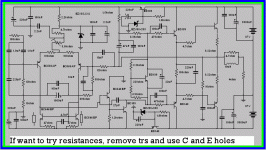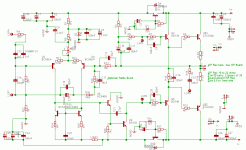I've been putting off this post for awhile, while I read back and forth through the threads, trying to come up with the answer myself.
In the end, I can't. I just don't know enough. So....I want to make the boards this weekend, and start to collect the components, but am not positive, which is the latest version of the HRII.
Is the PDF in post 3073 the correct one? Which schematic does it correspond to; the blue and green bordered one in the post just before it?
I'm sorry if this offends or annoys. I am somewhat of an oddity, as I can build all manner of things, but I don't know a darn thing. Believe me, I have tried to learn, but it's just not me. Most things go in one ear, and right out the other.
I made a couple of Joe Rasmussen's Tube buffered Gainclones, and all of the amps/crossovers in the Linkwitz Pluto speaker that I have. But, this is a bit too vague for my limited knowledge to decipher.
So, if you can give me a nudge in the right direction, it would be greatly appreciated.
Thanks and Regards,
Peter
http://picasaweb.google.com/fitero64/Various02
In the end, I can't. I just don't know enough. So....I want to make the boards this weekend, and start to collect the components, but am not positive, which is the latest version of the HRII.
Is the PDF in post 3073 the correct one? Which schematic does it correspond to; the blue and green bordered one in the post just before it?
I'm sorry if this offends or annoys. I am somewhat of an oddity, as I can build all manner of things, but I don't know a darn thing. Believe me, I have tried to learn, but it's just not me. Most things go in one ear, and right out the other.
I made a couple of Joe Rasmussen's Tube buffered Gainclones, and all of the amps/crossovers in the Linkwitz Pluto speaker that I have. But, this is a bit too vague for my limited knowledge to decipher.
So, if you can give me a nudge in the right direction, it would be greatly appreciated.
Thanks and Regards,
Peter
http://picasaweb.google.com/fitero64/Various02
Hi ecat,
Did you try the 22uF at the wire take-off point on the mother board, as mentioned earlier in relation to wire (circuit) inductance, and not on the sensor board itself ?
Some sub-miniature electrolytics are better than others, but you might never know unless you are in a position to try different makes beside each other to see which is the best.
Cheers .......... Graham.
Did you try the 22uF at the wire take-off point on the mother board, as mentioned earlier in relation to wire (circuit) inductance, and not on the sensor board itself ?
Some sub-miniature electrolytics are better than others, but you might never know unless you are in a position to try different makes beside each other to see which is the best.
Cheers .......... Graham.
Hello friends,
I have a question about the PCB.
It's important to have rail capacitors near the output devices. How big they should be?
I ask because between main reservoir caps (on another PCB, in my design) and the output transistor, there could be only 20cm of wire and some connectors. This increase the output impedance of the supply at high frequencies, but at low frequencies (where most 4700uF 63V are useful) it's a plain short, output bjt can take the current directly from the main reservoir capacitors.
So, it's important to provide 2200uF, maybe even 4700uF per rail directly on the PCB, or it's not important, given adequate bypass at HF (470uF low esr and some film cap)?
Advantages to eliminate big caps on the amp PCB:
- caps last longer because they're far from heatsink;
- more space available where good layout (that takes space) is critical;
- cheaper, so I can use bigger and better main PSU caps.
Thanks in advance for the replies.
I have a question about the PCB.
It's important to have rail capacitors near the output devices. How big they should be?
I ask because between main reservoir caps (on another PCB, in my design) and the output transistor, there could be only 20cm of wire and some connectors. This increase the output impedance of the supply at high frequencies, but at low frequencies (where most 4700uF 63V are useful) it's a plain short, output bjt can take the current directly from the main reservoir capacitors.
So, it's important to provide 2200uF, maybe even 4700uF per rail directly on the PCB, or it's not important, given adequate bypass at HF (470uF low esr and some film cap)?
Advantages to eliminate big caps on the amp PCB:
- caps last longer because they're far from heatsink;
- more space available where good layout (that takes space) is critical;
- cheaper, so I can use bigger and better main PSU caps.
Thanks in advance for the replies.
I have perceived (listened) them as important Giaime
But also i agree that 1000uf already produces a nice result.....maybe 470uf too.
I feel them important, not only near the ouput transistor colectors but also after the rail resistances.
The exception, in my mind, is when you have rail series regulators to feed the input stage, Vas stage and VBE multiplier...in this sittuation i felt, listening and substitution, that no advantage for big condensers into the input.
But...into the circuit i am using only rail resistances, no electronic series regulator, ...in this one, was clear the advantage of big condensers there.
In my prototype circuit, i have used 4 condensers, each one 3300uf....but 2 of them were substituted to 220uf after i perceive the input did not needed so big ones.
I conclude that those last weeks, no more than a month ago... searching for better sonics into the Dx amplifier....that resulted into the High Resolution one and model II....in the past i could not perceive difference, maybe because the standard Dx already has a very powerfull bass... and i could feel the difference into the bass.
I agree... 100 percent...the boards turns just awfull because of those "whale" sized condensers there...people could, at least accept some risk and use 35 volts units there to make the board less terrible.
Yes.... it may be a overkill the use of 3300uf..... the terrible thing is that i could listen advantages....i would prefer not to use so big ones... a nice 470uf 35 volts unit could be very pretty there.... a pitty that.
regards,
Carlos
........................................................................................................
Fítero
Here is the schematic, this one drawn by Ecat.
regards,
Carlos
.........................................................................................................
Folks
I had not problems using that 22uf condenser...it was soldered into the board.
regards,
Carlos
But also i agree that 1000uf already produces a nice result.....maybe 470uf too.
I feel them important, not only near the ouput transistor colectors but also after the rail resistances.
The exception, in my mind, is when you have rail series regulators to feed the input stage, Vas stage and VBE multiplier...in this sittuation i felt, listening and substitution, that no advantage for big condensers into the input.
But...into the circuit i am using only rail resistances, no electronic series regulator, ...in this one, was clear the advantage of big condensers there.
In my prototype circuit, i have used 4 condensers, each one 3300uf....but 2 of them were substituted to 220uf after i perceive the input did not needed so big ones.
I conclude that those last weeks, no more than a month ago... searching for better sonics into the Dx amplifier....that resulted into the High Resolution one and model II....in the past i could not perceive difference, maybe because the standard Dx already has a very powerfull bass... and i could feel the difference into the bass.
I agree... 100 percent...the boards turns just awfull because of those "whale" sized condensers there...people could, at least accept some risk and use 35 volts units there to make the board less terrible.
Yes.... it may be a overkill the use of 3300uf..... the terrible thing is that i could listen advantages....i would prefer not to use so big ones... a nice 470uf 35 volts unit could be very pretty there.... a pitty that.
regards,
Carlos
........................................................................................................
Fítero
Here is the schematic, this one drawn by Ecat.
regards,
Carlos
.........................................................................................................
Folks
I had not problems using that 22uf condenser...it was soldered into the board.
regards,
Carlos
Attachments
Re: I have perceived (listened) them as important Giaime
Hello Carlos,
Thank you very much for your reply. In fact, I have separate regulated PSU for the input + VAS. Those capacitors should only feed the drivers and the output bjts, and there are no rail resistances (rails connected directly to main reservoir caps on another pcb). Do you think I can get away with 1000uF or 470uF?
Hello Carlos,
destroyer X said:But also i agree that 1000uf already produces a nice result.....maybe 470uf too.
I feel them important, not only near the ouput transistor colectors but also after the rail resistances.
The exception, in my mind, is when you have rail series regulators to feed the input stage, Vas stage and VBE multiplier...in this sittuation i felt, listening and substitution, that no advantage for big condensers into the input.
But...into the circuit i am using only rail resistances, no electronic series regulator, ...in this one, was clear the advantage of big condensers there.
In my prototype circuit, i have used 4 condensers, each one 3300uf....but 2 of them were substituted to 220uf after i perceive the input did not needed so big ones.
I conclude that those last weeks, no more than a month ago... searching for better sonics into the Dx amplifier....that resulted into the High Resolution one and model II....in the past i could not perceive difference, maybe because the standard Dx already has a very powerfull bass... and i could feel the difference into the bass.
I agree... 100 percent...the boards turns just awfull because of those "whale" sized condensers there...people could, at least accept some risk and use 35 volts units there to make the board less terrible.
Yes.... it may be a overkill the use of 3300uf..... the terrible thing is that i could listen advantages....i would prefer not to use so big ones... a nice 470uf 35 volts unit could be very pretty there.... a pitty that.
regards,
Carlos
Thank you very much for your reply. In fact, I have separate regulated PSU for the input + VAS. Those capacitors should only feed the drivers and the output bjts, and there are no rail resistances (rails connected directly to main reservoir caps on another pcb). Do you think I can get away with 1000uF or 470uF?
Hello folks,
I order to clarify my lack of understanding, I beg someone to explain the meaning of details in the eCat diagram in post 3206:
1) Where are the inputs from the preamp? Are the LSP4 and LSP7 points?
2) What is the LINK1 for. What is it ?
3) What is the OP board ? Where are the outputs to the speaker ?
4)GND 1 and GND2 are to be connected where ?
5) What are the functions of X1 and X2 ?
6) Where to connect the 0 Volts from the power supply +37V, 0V,-37V ?
7) The Vbe multiplier is in a external board ?
Thank you
PERY
I order to clarify my lack of understanding, I beg someone to explain the meaning of details in the eCat diagram in post 3206:
1) Where are the inputs from the preamp? Are the LSP4 and LSP7 points?
2) What is the LINK1 for. What is it ?
3) What is the OP board ? Where are the outputs to the speaker ?
4)GND 1 and GND2 are to be connected where ?
5) What are the functions of X1 and X2 ?
6) Where to connect the 0 Volts from the power supply +37V, 0V,-37V ?
7) The Vbe multiplier is in a external board ?
Thank you
PERY
LSP4 In+
LSP7 In-
LINK is just a wire connection
LSP6 OUT+
What is the OP board (don't understand question)
GND 1 and GND2 are to be connected where (all grounds meet at starground
X1 X2 are just PCB mount spade connectors... you could also solder your wire there.. apply dab of glue on top of PCB to prevent it moveing and schafeing through.
0V goes to star ground
VBE is external...look at VBE section on the WWW link below my post to see the vanila DX VBE board... the proper name for this board is a bias servo. You just need a small piece of stripboard to wire one up.
If you want The PDF of the copper traces to etch your own, just let us know... and I'll repost it for you.
Carlos will enjoy haveing someone to speak some Portuguese to here... so, welcome...!!!!!!!!!
LSP7 In-
LINK is just a wire connection
LSP6 OUT+
What is the OP board (don't understand question)
GND 1 and GND2 are to be connected where (all grounds meet at starground
X1 X2 are just PCB mount spade connectors... you could also solder your wire there.. apply dab of glue on top of PCB to prevent it moveing and schafeing through.
0V goes to star ground
VBE is external...look at VBE section on the WWW link below my post to see the vanila DX VBE board... the proper name for this board is a bias servo. You just need a small piece of stripboard to wire one up.
If you want The PDF of the copper traces to etch your own, just let us know... and I'll repost it for you.
Carlos will enjoy haveing someone to speak some Portuguese to here... so, welcome...!!!!!!!!!
hi Nordic,
that coil is the output inductor.
It can be paralleled with a resistor. Thiele's original circuit omitted the resistor.
The other part of the Thiele circuit (network) is the series R+C.
Many amps use just the Zobel half.
Some designers say the output inductor, with or without it's parallel resistor degrades the sound quality.
I prefer the full Thiele network. R+C to ground and series feed to speaker of L//R.
that coil is the output inductor.
It can be paralleled with a resistor. Thiele's original circuit omitted the resistor.
The other part of the Thiele circuit (network) is the series R+C.
Many amps use just the Zobel half.
Some designers say the output inductor, with or without it's parallel resistor degrades the sound quality.
I prefer the full Thiele network. R+C to ground and series feed to speaker of L//R.
Andrew and Graham,
Thanks for your help, something to try out when I get home.
Pery,
The OP board is a figment of my imagination. Just an idea I had to free up some room on the main board. The free version of Eagle used by both Nordic and myself for the board design only provides a single board size, this is just to small for comfort when it comes to the HRII.
X3, X5 and X6 are the ground points. Think of X3 as the main ground, X5 and X6 are extra points that can be connected back to the main star. The idea comes directly from the Dx vanilla (I think 'Dx Classic' sounds better ), look at the web link in Nordics posts and see what it says about ELINK+ and ELINK-.
), look at the web link in Nordics posts and see what it says about ELINK+ and ELINK-.
Thanks for your help, something to try out when I get home.
Pery,
The OP board is a figment of my imagination. Just an idea I had to free up some room on the main board. The free version of Eagle used by both Nordic and myself for the board design only provides a single board size, this is just to small for comfort when it comes to the HRII.
X3, X5 and X6 are the ground points. Think of X3 as the main ground, X5 and X6 are extra points that can be connected back to the main star. The idea comes directly from the Dx vanilla (I think 'Dx Classic' sounds better
Yes... Pery around is fine... i will answer him into direct mail latter
Good that Andrew is helping you Nordic.... i am hardly busy and this help, from someone that has Andrew Knowledge is very appreciates...also Graham help is always appreciated, even we we have some disagreement.... well...this happens...and the biggest chance is that i would be wrong, as Graham is better in electronics.
regards,
Carlos
........................................................................................................
Latter dear Pery (tou enrolado, assoberbado, atormentado, abalado, complicado, compromissado e descacetado) i will take a look into your needs..for sure you will receive special direct attention as we speak the same language and we have born same town (Rio).
Abraços,
Carlos
.......................................................................................................
Giaime
I think you do not need to loose your time with my circuit.... because your circuit is better into the input.. i have strong intentions to use it, matching it with my output and some ideas i have boiling here.... this to December... after 2 or 3 folks constructed High Resolution II.
If result sonically good (we never know)...mixing good things alike strawberries and chocolate, for instance, result bad taste... also "Dr. Frankstein's alike" amplifiers can sound ship too.
I can kill your input with my output and modifications, and the opposite can happens too.
Of course, your Name will be mentioned as the designer of the input...with many thanks and etceteras... and so on.... with your permission fratello.
But really..... talking frankly.... de véro.... better you to offer more options to our forum.... doing the whole job into your idea (I do not like the output...my problem maybe)... producing boards, layout, constructing prototype, testing and offering people support..this will turn forum better, with options, and you will block my intentions to COPY your input...ahahahahaha.
Of course i feel honored with your attention, but i think this is an enormous waste of time.... it seems you know more than i know.
regards,
Carlos
Good that Andrew is helping you Nordic.... i am hardly busy and this help, from someone that has Andrew Knowledge is very appreciates...also Graham help is always appreciated, even we we have some disagreement.... well...this happens...and the biggest chance is that i would be wrong, as Graham is better in electronics.
regards,
Carlos
........................................................................................................
Latter dear Pery (tou enrolado, assoberbado, atormentado, abalado, complicado, compromissado e descacetado) i will take a look into your needs..for sure you will receive special direct attention as we speak the same language and we have born same town (Rio).
Abraços,
Carlos
.......................................................................................................
Giaime
I think you do not need to loose your time with my circuit.... because your circuit is better into the input.. i have strong intentions to use it, matching it with my output and some ideas i have boiling here.... this to December... after 2 or 3 folks constructed High Resolution II.
If result sonically good (we never know)...mixing good things alike strawberries and chocolate, for instance, result bad taste... also "Dr. Frankstein's alike" amplifiers can sound ship too.
I can kill your input with my output and modifications, and the opposite can happens too.
Of course, your Name will be mentioned as the designer of the input...with many thanks and etceteras... and so on.... with your permission fratello.
But really..... talking frankly.... de véro.... better you to offer more options to our forum.... doing the whole job into your idea (I do not like the output...my problem maybe)... producing boards, layout, constructing prototype, testing and offering people support..this will turn forum better, with options, and you will block my intentions to COPY your input...ahahahahaha.
Of course i feel honored with your attention, but i think this is an enormous waste of time.... it seems you know more than i know.
regards,
Carlos
Attachments
You're too generous
Naaaaaaah!!!
destroyer X said:Of course i feel honored with your attention, but i think this is an enormous waste of time.... it seems you know more than i know.
regards,
Carlos
Naaaaaaah!!!
Attachments
Hi Carlos,
you wrote;-
>> also Graham help is always appreciated, even we we have some disagreement.... well...this happens...and the biggest chance is that i would be wrong, as Graham is better in electronics. regards, Carlos <<
Well Carlos, there will always remain a difference between theory and practice; this difference relating to implementation and whether theoretical correctness is directly applicable.
Thus I must always bow to your hands-on findings with these circuits which you have developed, tested, and which you know from direct experience, for it is I who could be wrong with your circuit.
I would rather not think of there being 'disagreements', rather a sharing of ideas and a best use of same, which seems to be a rather nice aspect of this thread.
Cheers .......... Graham.
you wrote;-
>> also Graham help is always appreciated, even we we have some disagreement.... well...this happens...and the biggest chance is that i would be wrong, as Graham is better in electronics. regards, Carlos <<
Well Carlos, there will always remain a difference between theory and practice; this difference relating to implementation and whether theoretical correctness is directly applicable.
Thus I must always bow to your hands-on findings with these circuits which you have developed, tested, and which you know from direct experience, for it is I who could be wrong with your circuit.
I would rather not think of there being 'disagreements', rather a sharing of ideas and a best use of same, which seems to be a rather nice aspect of this thread.
Cheers .......... Graham.
- Status
- Not open for further replies.
- Home
- Amplifiers
- Solid State
- Destroyer x Amplifier...Dx amp...my amplifier




